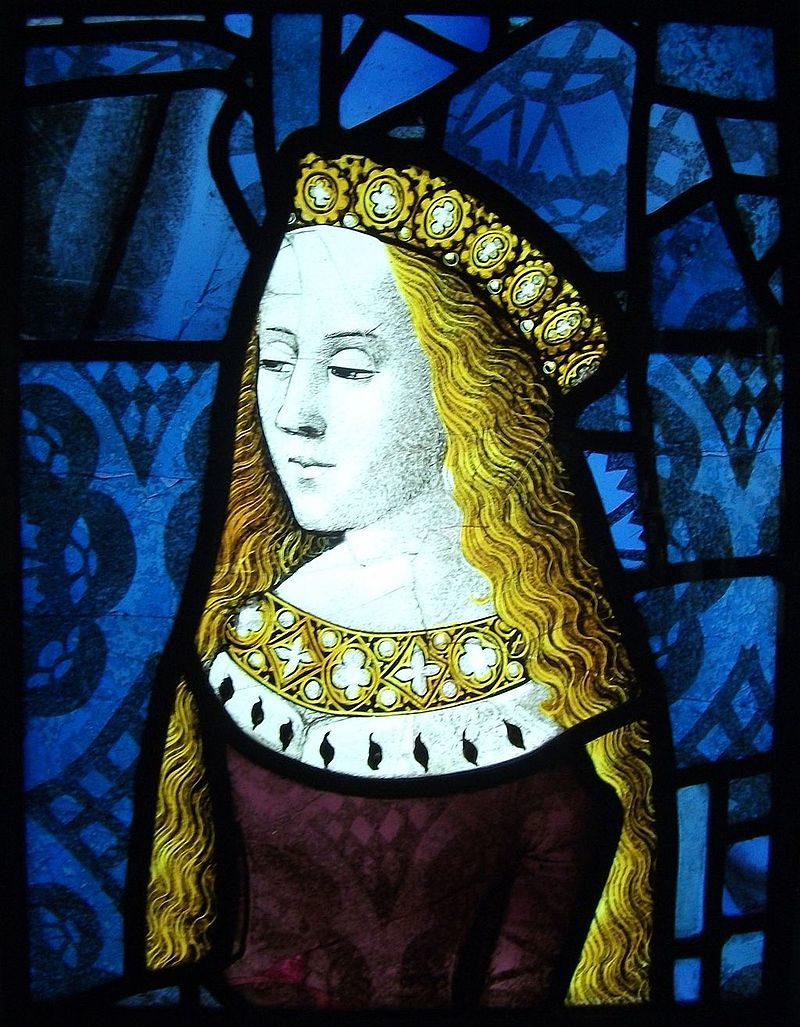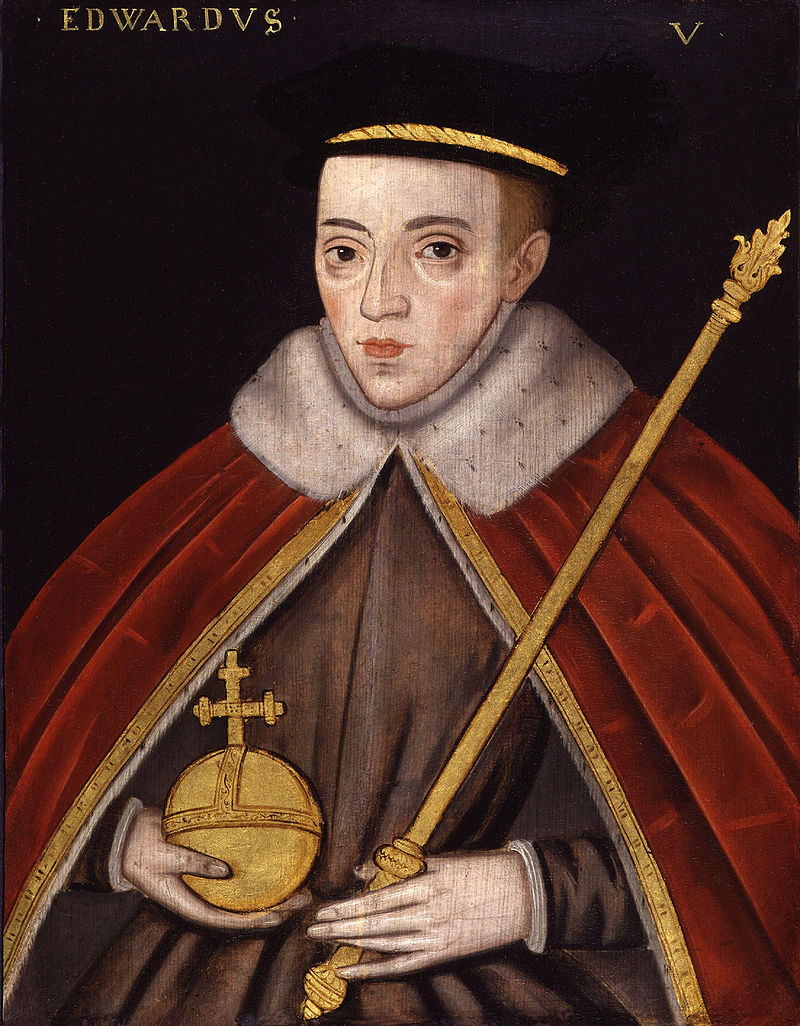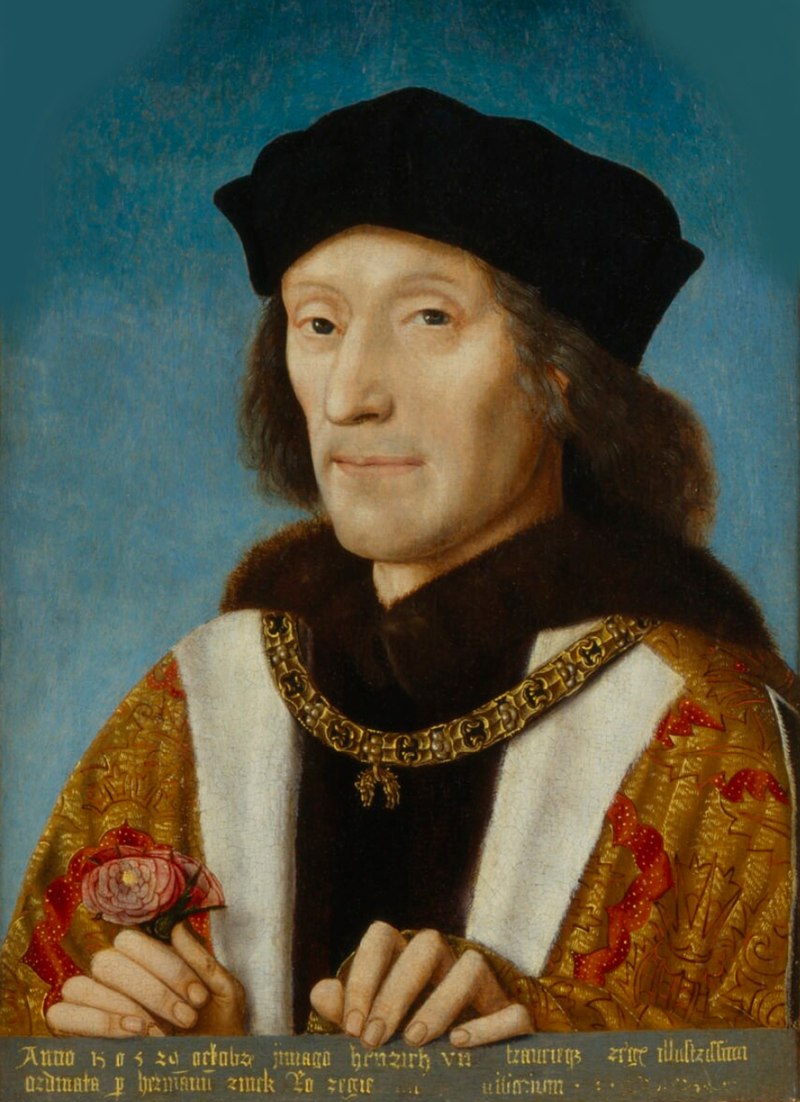by Susan Flantzer
© Unofficial Royalty 2023

Cecily of York, Viscountess Welles, Credit – Wikipedia
Born on March 20, 1469, at the Palace of Westminster in London, England, Cecily of York, Viscountess Welles was the third of the ten children and the third of the seven daughters of King Edward IV of England, the first King of England from the House of York, and Elizabeth Woodville. The birth of Cecily, the third daughter in a row, was a great disappointment to King Edward IV. For the first time, he suggested that he may not have sons and that the crown could pass to his eldest daughter Elizabeth. Cecily’s paternal grandparents were Richard of York, 3rd Duke of York and her namesake Cecily Neville, both great-grandchildren of King Edward III of England. Her maternal grandparents were Sir Richard Woodville, 1st Earl Rivers and Jacquetta of Luxembourg.

Cecily’s father King Edward IV of England; Credit – Wikipedia
Cecily’s father King Edward IV was the eldest surviving son of Richard of York, 3rd Duke of York who had a strong claim to the English throne. The social and financial troubles that followed the Hundred Years’ War, combined with the mental disability and weak rule of the Lancastrian King Henry VI had revived interest in the claim of Richard, 3rd Duke of York. The Wars of the Roses were fought between supporters of two rival branches of the royal House of Plantagenet, the House of Lancaster and the House of York between 1455 and 1487. Richard, 3rd Duke of York was killed on December 30, 1460, at the Battle of Wakefield and his son Edward was then the leader of the House of York. After winning a decisive victory on March 2, 1461, at the Battle of Mortimer’s Cross, 19-year-old Edward proclaimed himself king. In 1464, King Edward IV married Elizabeth Woodville.
Cecily’s mother Elizabeth Woodville; Credit – Wikipedia
Cecily had nine siblings:
- Elizabeth of York (1466 – 1503), married King Henry VII of England, had seven children including King Henry VIII of England, Margaret Tudor, Queen of Scots, and Mary Tudor, Queen of France
- Mary of York (1467 – 1482), unmarried, died in her teens
- King Edward V of England (1470 – circa 1483), briefly succeeded his father, as King Edward V of England, was the elder of the Princes in the Tower
- Margaret of York (born and died 1472)
- Richard of Shrewsbury, 1st Duke of York (1473 – circa 1483), was the younger of the Princes in the Tower
- Anne of York (1475 – 1511), married Thomas Howard (later 3rd Duke of Norfolk and uncle of Anne Boleyn and Catherine Howard, King Henry VIII’s beheaded wives), had no surviving children
- George Plantagenet, 1st Duke of Bedford (1477 – 1479), died in childhood probably from the bubonic plague
- Catherine of York (1479 – 1527), married William Courtenay, 1st Earl of Devon, had two sons and one daughter
- Bridget of York (1480 – 1517), became a nun
Cecily had two half-brothers from her mother’s first marriage to Sir John Grey of Groby:
- Thomas Grey, 1st Marquess of Dorset (1455 – 1501), married (1) Anne Holland, no children; (2) Cecily Bonville, 7th Baroness Harington and 2nd Baroness Bonville, had 14 children; Thomas and Cecily are the great-grandparents of Lady Jane Grey
- Sir Richard Grey (1457 – 1483), unmarried, executed by Richard, Duke of Gloucester (future King Richard III)
In October 1470, thanks to Richard Neville, 16th Earl of Warwick, known as “The Kingmaker,” switching from the Yorkist faction to the Lancastrian faction, King Henry VI from the House of Lancaster was restored to the throne. King Edward IV and his brother Richard, Duke of Gloucester (the future Richard III) fled to Flanders, part of Burgundy, where their sister Margaret of York was married to Charles I the Bold, Duke of Burgundy. Seven-month-old Cecily went into sanctuary at Westminster Abbey in London with her pregnant mother and her older sisters Elizabeth and Mary. While in sanctuary, Cecily’s brother Edward (the future Edward V) was born. By April 1471, Cecily’s father was back on the throne, and a month later King Henry VI was murdered in the Tower of London.
Cecily was probably brought up by Lady Margaret Berners (wife of John Bourchier, 1st Baron Berners, great-grandson of King Edward III), who was the governess of her elder sisters Elizabeth and Mary. On July 30, 1476, Cecily attended the grand reburial of her paternal grandfather Richard Plantagenet, 3rd Duke of York and his second son and Cecily’s paternal uncle Edmund, Earl of Rutland at the Church of Saint Mary and All Saints in Fotheringhay, Northamptonshire, England. Her grandfather and uncle had been killed in 1460 at the Battle of Wakefield, during the Wars of the Roses. Their bodies had been displayed and then unceremoniously buried. Cecily attended the wedding of her four-year-old brother Richard of Shrewsbury, 1st Duke of York and the five-year-old wealthy heiress Anne de Mowbray, 8th Countess of Norfolk (1472 – 1481) at St. Stephen’s Chapel in the Palace of Westminster in London, England on January 15, 1478. In May 1480, Cecily and her older sister Mary were created Ladies of the Order of the Garter. Their older sister Elizabeth had been named Lady of the Garter in February 1480.
In 1474, King Edward IV and James III, King of Scots negotiated a treaty and a marriage between five-year-old Cecily and the one-year-old heir to the Scottish throne, James, Duke of Rothesay (later James IV, King of Scots). The formal betrothal took place in Edinburgh, Scotland on October 26 or December 26, 1474, with David Lindsay, 5th Earl of Crawford representing James and John Scrope, 5th Baron Scrope of Bolton representing Cecily. The marriage would occur when they both reached marriageable age.
The treaty and the proposed marriage were very unpopular in Scotland. Even though there was a treaty, there were further military conflicts between Edward IV and James III. Edward IV continued to make payments on the generous dowry until 1482 when he broke off the betrothal to James, Duke of Rothesay and betrothed Cecily to Alexander Stewart, Duke of Albany. The Duke of Albany was the younger brother of James III and had laid a claim to the Scottish throne. Edward IV supported the Duke of Albany’s claim providing him with an army and his younger brother Richard, Duke of Gloucester (the future King Richard III). Richard negotiated a treaty with the merchants of Edinburgh, Scotland to repay the dowry. Edward IV accepted the dowry repayment and officially broke Cecily’s engagement to James, Duke of Rothesay. In 1503, James, Duke of Rothesay, then James IV, King of Scots, married Cecily’s niece Margaret Tudor. King Edward IV died in 1483 and the Duke of Albany lost his main source of power, so the marriage with Cecily never occurred.

Cecily’s brother King Edward V of England, one of the missing Princes in the Tower; Credit – Wikipedia
When King Edward IV died and his twelve-year-old son succeeded him as King Edward V, Edward IV’s brother, Richard, Duke of Gloucester, was named Lord Protector of his young nephew and moved to keep the Woodvilles, the family of Edward IV’s widow Elizabeth Woodville, from exercising power. The widowed queen sought to gain political power for her family by appointing family members to key positions and rushing the coronation of her young son. The new king was accompanied to London by his maternal uncle Anthony Woodville, 2nd Earl Rivers and his half-brother Sir Richard Grey. Rivers and Grey were accused of planning to assassinate Richard, were arrested, and taken to Pontefract Castle, where they were later executed without trial. Richard then proceeded with the new king to London where Edward V was presented to the Lord Mayor of London. For their safety, King Edward V and his nine-year-old brother Richard, Duke of York were sent to the Tower of London and were never seen again.
On June 22, 1483, a sermon was preached at St. Paul’s Cross in London declaring Edward IV’s marriage to Elizabeth Woodville invalid and his children illegitimate. This information came from Robert Stillington, Bishop of Bath and Wells, who claimed a legal pre-contract of marriage to Eleanor Butler, had invalidated King Edward IV’s later marriage to Elizabeth Woodville. The citizens of London presented Richard with a petition urging him to assume the throne, and he was proclaimed king on June 26, 1483. King Richard III and his wife Anne Neville were crowned in Westminster Abbey on July 6, 1483, and their son Edward of Middleham was created Prince of Wales. In January 1484, Parliament issued the Titulus Regius, a statute proclaiming Richard the rightful king. In 1485, King Richard III arranged for a marriage for Cecily to someone below her in status to rule out her claim to the throne: Ralph Scrope, the son of Thomas Scrope, 5th Baron Scrope of Masham.

Cecily’s brother-in-law King Henry VII of England; Credit – Wikipedia
On August 22, 1485, Henry Tudor from the House of Lancaster defeated King Richard III at the Battle of Bosworth Field and became King Henry VII, the first Tudor king of England. On January 18, 1486, Henry VII married Cecily’s eldest sister Elizabeth of York uniting the House of Lancaster and the House of York into the new House of Tudor. Henry VII had Parliament repeal the Titulus Regius, the act that declared King Edward IV’s marriage invalid and his children illegitimate, thereby legitimizing his wife. Cecily’s marriage to Ralph Scrope was annulled in 1486 because the marriage was not in the interests of the new Tudor dynasty.

Cecily’s sister Elizabeth of York, wife of King Henry VII and mother of King Henry VIII; Credit – Wikipedia
Sometime between November 25, 1487 and January 1, 1488, Cecily married a nobleman loyal to King Henry VII, John Welles, 1st Viscount Welles (circa 1450 – 1498), the younger half-brother of King Henry VII’s mother Lady Margaret Beaufort. John died of pleurisy on February 9, 1498, and was buried in Westminster Abbey in London, England.
Cecily and John had two daughters Elizabeth and Anne who both died in childhood:
- Elizabeth Welles (circa 1489 – 1498
- Anne Welles (circa 1491 – 1499)
After the death of her husband and daughters, Cecily returned to the court seeking comfort and protection from her older sister Queen Elizabeth. Lady Margaret Beaufort, Henry VII’s mother, also helped Cecily to protect her rights to her deceased husband’s property, claimed by his half-sisters. On February 2, 1503, Cecily’s sister Elizabeth gave birth to a daughter Katherine. Shortly after giving birth, Elizabeth became ill with puerperal fever (childbed fever) and died on February 11, 1503, her 37th birthday. Elizabeth’s death so shook Henry VII that he went into seclusion and would only see his mother. Little Katherine died on February 18, 1503. Cecily was equally upset. Not only did she lose her sister, but also a close friend and patroness, on whom she could always count.
Sometime between May 13, 1502 and January 1504, Cecily married Sir Thomas Kyme without the permission of King Henry VII. Cecily and Thomas probably had two children, Richard Kyme and Margaret Kyme. Some sources say that Cecily’s third marriage was childless, possibly because King Henry VII did not recognize her third marriage or the children born from the marriage.

The ruins of old Quarr Abbey were Cecily was probably buried; By Mypix – Own work, CC BY-SA 4.0, https://commons.wikimedia.org/w/index.php?curid=64107857
Cecily died on August 24, 1507, aged 38, but her place of death and burial site are uncertain. Most likely, she died on the Isle of Wight, England, and was buried at Quarr Abbey, Isle of Wight. Past historians have said that the memorial marking Cecily’s grave was destroyed in the Dissolution of the Monasteries during the reign of her nephew King Henry VIII and no description of the memorial survived. However, there is evidence from the account books of Lady Margaret Beaufort, who paid part of Cecily’s funeral expenses, that Cecily died in Hatfield, Hertfordshire, England after a three-week stay there, and was buried at a local place, possibly King’s Langley Priory in Kings Langley, England.
This article is the intellectual property of Unofficial Royalty and is NOT TO BE COPIED, EDITED, OR POSTED IN ANY FORM ON ANOTHER WEBSITE under any circumstances. It is permissible to use a link that directs to Unofficial Royalty.
Works Cited
- Cecily of York (2022) Wikipedia. Wikimedia Foundation. Available at: https://en.wikipedia.org/wiki/Cecily_of_York (Accessed: January 11, 2023).
- Flantzer, Susan. (2016) Elizabeth of York, Queen of England, Unofficial Royalty. Available at: https://www.unofficialroyalty.com/elizabeth-of-york-queen-of-england/ (Accessed: January 11, 2023).
- Flantzer, S. (2016) King Edward IV of England, Unofficial Royalty. Available at: https://www.unofficialroyalty.com/king-edward-iv-of-england/ (Accessed: January 11, 2023).
- John Welles, 1st Viscount Welles (2022) Wikipedia. Wikimedia Foundation. Available at: https://en.wikipedia.org/wiki/John_Welles,_1st_Viscount_Welles (Accessed: January 11, 2023).
- Weir, Alison. (1989) Britain’s Royal Families: The Complete Genealogy. London: Vintage Books.
- Williamson, David. (1996) Brewer’s British Royalty: A Phrase and Fable Dictionary. London: Cassell.
